If you want to build bigger and stronger chest muscles, cable fly is one of the best exercises you can do.
As your chest muscles strengthen, you challenge them in different ways to grow them. You need variety, intensity, and frequency to achieve this.
And cable chest flies are one of the best ways to add variety and intensity to chest exercises.
In this blog, we’ll cover what cable fly is, the muscles worked by cable fly, and variations to transform your chest development.
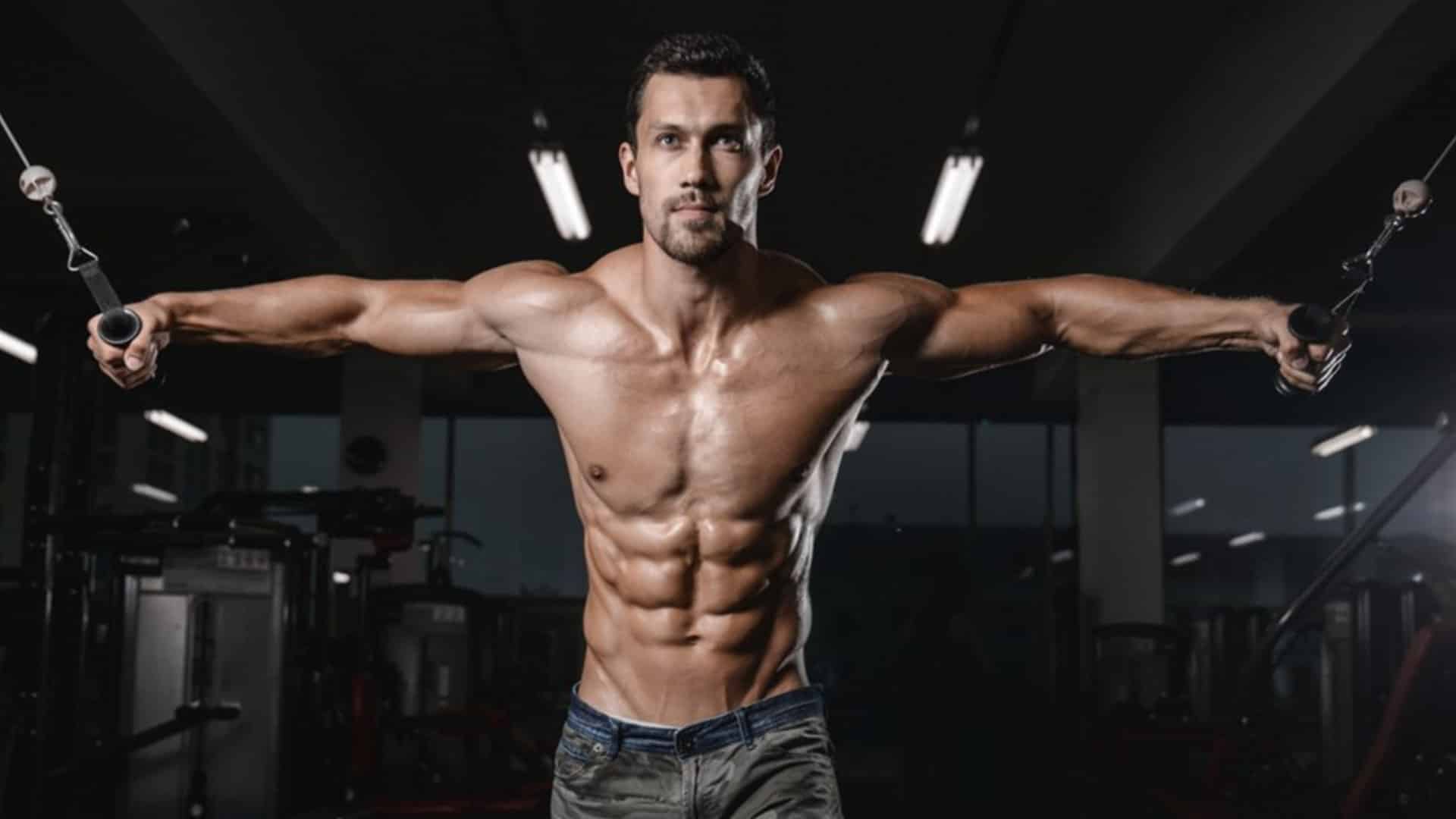
- What is Cable Chest Fly
- Muscle Worked During Cable Fly
- 7 Best Cable Fly Variations To Build a Bigger Chest
- 1. Standing Cable Fly
- 2. Cable Fly for Upper Chest (Low to High Cable Fly)
- 3. Cable Fly for Lower Chest (High to Low Cable Fly)
- 4. Incline Cable Fly
- 5. Decline Cable Fly
- 6. Single Arm Chest Fly
- 7. Seated Cable Pec Fly
- Chest Muscles Anatomy
- How To Add Cable Chest Fly into Your Workout Routine
- Benefits of the Cable Chest Fly
- FAQs
- Takeaway
What is Cable Chest Fly
The cable chest fly is an isolation exercise that primarily targets the chest muscles (pectorals) and also engages the anterior deltoids and triceps to a lesser extent.
Research shows that standing cable exercises, like cable flies, work your chest and shoulders but also heavily engage your core for stability.
Unlike compound exercises like the bench press, cable chest flyes specifically isolate the chest, minimizing the involvement of other muscle groups.
The exercise can be adjusted to target different areas of the chest by changing the height of the cables.
- High Cable Chest Fly: Targets the lower portion of the pectorals.
- Mid-Cable Chest Fly: Focuses on the inner region of the pectorals.
- Low Cable Chest Fly Emphasizes the upper portion of the pectorals.
Muscle Worked During Cable Fly
The primary muscles worked during cable flyes are:
- Pectoralis Major (Chest)
Secondary muscles and supporting muscles worked during it include:
- Triceps
- Anterior deltoids,
Some other muscles are stabilizers, including:
- Wrist flexors,
- Biceps
- Core Muscles: obliques, and rectus abdominis.
- Rhomboids, levator scapulae, and latissimus dorsi.
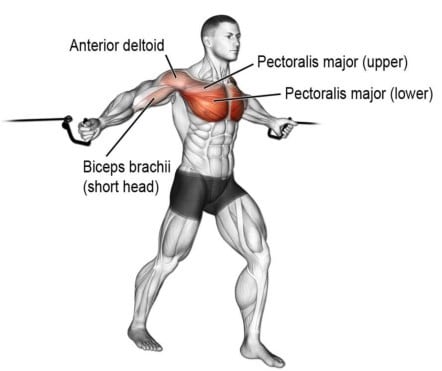
7 Best Cable Fly Variations To Build a Bigger Chest
There are many benefits to doing different variations of the cable chest fly.
- Targets different parts of the chest muscles.
- Adds variety to your workout routine
- Helps to break through plateaus
- It helps to add variety and prevent boredom.
- Lead to greater muscle growth and definition.
For example:
- Standing Cable Fly: Chest, Front Shoulder
- Low to High Cable Fly: Cable Fly for Upper Chest
- High to Low Cable Fly: Cable Fly for Lower Chest
- Incline Cable Fly: Upper Pectoralis Major (Upper Chest)
- Decline Cable Fly: Lower Pectoralis Major (Lower Chest)
- Single Arm Chest Fly: Pectoralis Major (Chest, focus on the working side)
- Seated Cable Pec Fly: Inner Chest and Front Delt.
Here is the best cable chest fly variation that helps build a bigger and wider chest.
1. Standing Cable Fly
Cable PEC fly, also known as cable crossover fly exercises, helps to build huge pectorals.
Unlike exercises performed seated or lying down, the standing cable fly actively engages your core muscles for balance and stability.
The arcing motion of the standing cable fly is generally easier on the shoulder joints compared to some dumbbell fly variations.

How To Do Standing Cable Fly
- Set the cable pulleys to shoulder height.
- Stand between the pulleys with feet staggered for balance (one foot slightly in front of the other).
- Maintain a slight forward lean with knees slightly bent.
- Grasp the cable handles with palms facing each other.
- Bend slightly forward and extend your arms, feeling a good stretch in your chest muscles.
- Now, flex your arms with elbows slightly bent and get a good chest contraction.
- Unlike chest flies, you can cross over the center to get full Pec contraction.
- Slowly control the return to the start.
Tip
- Squeeze your chest at the end of the movement.
- Exhale as you squeeze, inhale as you return.
- aintain a neutral spine and keep your shoulders pulled back
2. Cable Fly for Upper Chest (Low to High Cable Fly)
The standing low to high cable fly is a variation of the chest fly and an exercise used to strengthen the pushing muscles of the body, including the chest, Tricep, and shoulders.
It primarily targets the upper pectorals by pulling the arms from a low to high angle.
The cable helps develop upper chest muscles and provides much-needed stress for those who want to build up their muscles.

How To Do Low to High Cable Fly
- Adjust the pulleys to the lowest position on both sides.
- Grasp the cable attachments in each hand using an overhand grip.
- Bend slightly forward and extend your arms, feeling a good stretch in your chest muscles.
- Bend your elbows and pull your hands toward each other in wide arcs in front of you.
- Move your hands upward until they are above your chest or the cables cross over.
- Slowly lower back to the starting position.
Tip
- To maintain your balance, take a staggered stance.
- When you breathe in, bring the handles up and together.
- Control the weight as you bring your arms back down.
Know More: 14 Best Cable Chest Exercises And Workout Routine
3. Cable Fly for Lower Chest (High to Low Cable Fly)
Often, our upper chest gets all the attention. Targeting the lower pecs will help prevent imbalances and improve overall chest strength.
The high-to-low cable fly is a variation of the chest fly and is a great exercise to target the lower portion of your chest.
Instead of your hands moving straight across, you’ll create a downward arc, hitting the lower chest fibers hard.
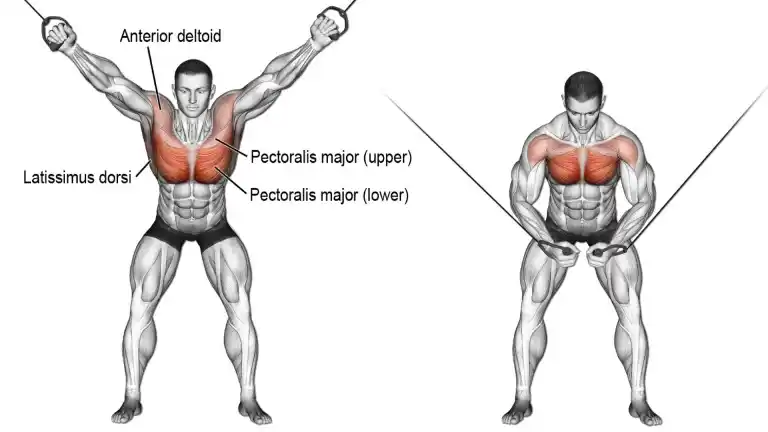
How To Do High to Low Cable Fly
- Set both pulleys as high as possible and select the desired weight.
- Stand between the towers, and feet staggered for stability.
- Keep a bend in your knees as you lean forward.
- Grip the handles with your palms facing each other.
- Bend your elbows slightly and pull your hands (high to low) toward each other in wide arcs in front of you, pausing when your hands touch.
- Slowly lower back to the starting position.
Tip
- Ensure you maintain some tension in your abs, and don’t allow your lower back to arch excessively.
- Focus on the form before choosing a heavyweight.
- As you pull the handles together, breathe out.
4. Incline Cable Fly
Incline cable fly is one of the most suitable exercises for isolating the upper chest muscles.
Performing this exercise with cables instead of dumbbells allows for constant tension, which helps build Upper Chest fibers.
The study found that the most activity for the upper part of the pectoralis major muscle has occurred when the bench was angled at 30 degrees.

How To Do Incline Cable Fly
- Set an incline bench at a 30-to-45-degree angle. Lie on the bench with your feet flat on the floor.
- Lift your arms straight up from your shoulders and hold the cable directly over your upper chest.
- Slowly lower your arms to your sides until your wrists reach about shoulder level or slightly above.
- Bring your arms back toward the midline of your body, focusing on using your pec muscles to draw them back together.
Tips
- Vary the position of the bench to hit different angles of the upper chest.
- Hold and contract the pec muscles when your hands are together.
- Set the bench at about 30–45 degrees inclined.
- Do not go more upright because the stress will shift to your shoulders instead of your chest.
Know More: Upper Chest Cable Exercises For Bigger & Stronger Chest
5. Decline Cable Fly
Decline cable fly is one of the most suitable exercises for isolating the lower chest muscles.
It has a more even resistance curve than dumbbell chest flyes, so the load is more consistent throughout the whole range of motion.
It allows a person to maximize the range of motion at the bottom of the exercise while also maximizing muscle activation at the top.
Using cables instead of dumbbells to do this exercise allows for constant tension to help build the lower chest fibers.

How To Do Decline Cable Fly
- Set a decline bench at a 30-degree angle.
- Lie on the bench with your feet flat on the foot pad or the roller.
- Lift your arms straight up from your shoulders and hold the cable handle directly over your chest.
- Slowly lower your arms to your sides until your wrists reach about shoulder level or slightly above.
- Move your arms back to the middle of your body by using your lower pec muscles to bring them together.
Tips
- Breathe out as you exert.
- When your hands are together, hold and squeeze the chest muscles.
- Set the bench at a 30-degree (decline) angle.
Know More: Lower Chest Cable Exercises For Bigger & Stronger Chest
6. Single Arm Chest Fly
The one-arm fly is a unilateral variation of the fly. It is used by those who want to focus on the inner chest.
Training one side at a time highlights any strength differences between your right and left sides. Addressing this builds a more balanced and symmetrical chest.

How To Do Single-Arm Chest Fly
- Adjust the pulley on a cable machine to the desired height, typically at chest level.
- Attach a D-handle to the pulley.
- Grab the handle with the hand opposite the working side of your chest.
- Extend your arm and make sure to have a slight bend in your elbow.
- Exhale and slowly bring the handle across your body in a wide arc motion.
- Hold for a second, and return to the starting position to complete one rep.
- Do 10–12 repetitions on each side per set.
Tips
- Always keep your elbows slightly bent for maximum inner pec activation.
- Ensure to keep your core engaged throughout the movement and breathe
- Keep your motions controlled and avoid jerky movements.
7. Seated Cable Pec Fly
The seated position eliminates the balancing act involved in standing variations.
This allows you to isolate your chest muscles completely and fully concentrate on feeling them work.
Pushing your torso against the bench can allow you to focus on the mind-muscle connection and move more weight.
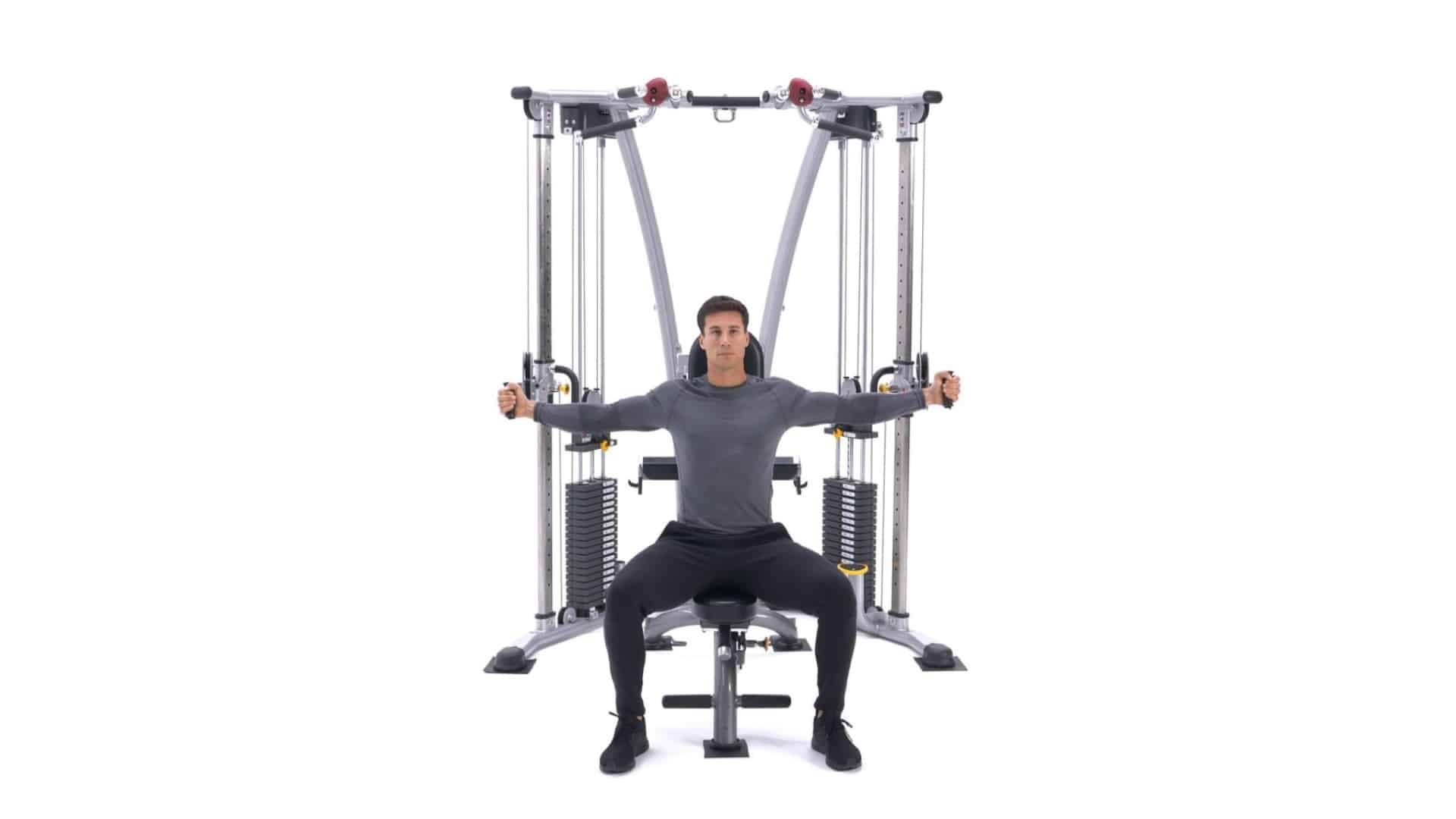
How To Do Seated Cable Pec Fly
- Seated on a bench, take hold of each cable and position the handles directly in front of your chest.
- Extend your arms, feeling a good stretch in your chest muscles.
- Now, flex your arms with elbows slightly bent and get a good chest contraction.
- Unlike pec fly, you can cross over the center for full Pec contraction.
Tip
- Hold and contract the chest muscles when hands are together.
- Always keep your arms bent to protect the shoulder joint.
- Breathe in on the relaxation phase and breathe out when contracting, always keeping your head up.
Chest Muscles Anatomy
The chest muscles consist of the pectoralis major and the pectoralis minor.
The pectoralis major itself comprises two heads, each of which may be worked differently depending on the angle of adduction:
- An upward angle of movement emphasizes the upper or clavicular head, (upper chest)
- While a lower angle emphasizes the lower or sternal head of the muscle (Lower chest)
The pectoralis minor is the triangle-shaped muscle located under the pectoralis major, a layer deeper, and draws the shoulder blades down and forward.
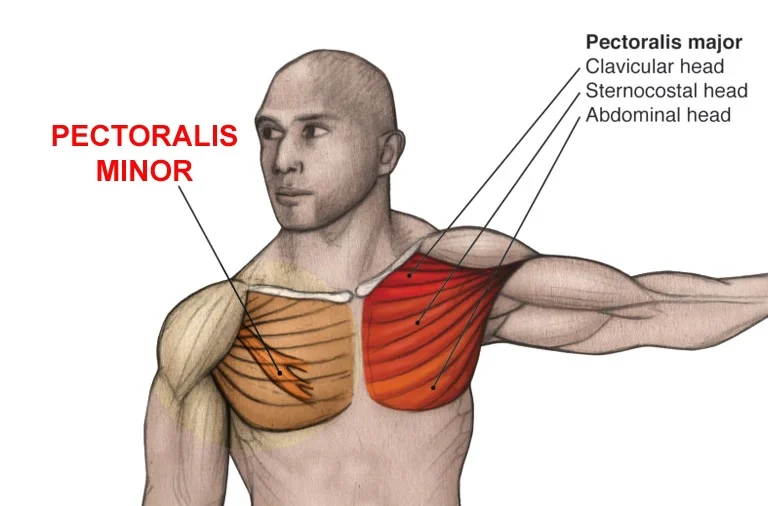
How To Add Cable Chest Fly into Your Workout Routine
If you want to incorporate cable chest fly into your workout routine, here are some tips to help you get started.
1. Sets and reps
| Category | Sets | Reps | Rest |
|---|---|---|---|
| Beginners | ~10 sets per week | 3 sets of 8–12 reps | 1–2 min between sets |
| Intermediate | ~15 sets per week | 3-4 sets of 8–12 reps | 1–2 min between sets |
| Advanced | ~20 sets per week | Varies based on goals | 1 min between sets |
2. Training Volume
Strength, Hypertrophy and Endurance table of Mell Siff’s Supertraining
- Strength Gains: To build your lower chest muscles, strength, do 2 to 6 sets of exercises and do 3-5 reps. Use a load that is at least 85% of your one-repetition maximum (1RM). For fewer reps, aim for closer to 90% of your 1RM.
- Hypertrophy (Muscle Growth) To promote muscle growth perform 3-4 sets of each exercise and 8 to 12 reps per set. Use a load that falls within the range of 60 to 80% of your 1RM.
- Endurance: The purpose of endurance training is to enhance both cardiovascular and muscular endurance. Use a load that falls within 40 to 60% of your 1RM range. Aim for 15 to 40 reps per set.
3. Combining with other chest exercises
Combined cable fly with other chest exercises, like bench press, push-ups, and dumbbell flys, to make a good chest workout.
When combining exercises, be sure to vary the angles and resistance to target the chest muscles in different ways.
It can be performed 1–2 times weekly, depending on your overall workout schedule and goals.
4. Used as a Finisher
Cable fly variations can be used as a finishing exercise at the end of your chest workout.
This helps to exhaust your chest muscles and increase blood flow, leading to greater muscle growth and definition.
Benefits of the Cable Chest Fly
1. Increased Chest Muscle Activation
Cable chest fly activates the chest muscles more than traditional exercises like the bench press.
The cable machine keeps the muscles active throughout the entire range of motion.
2. Improved Muscle Balance
Cable fly helps improve muscle balance by targeting the chest muscles from different angles.
This can help to correct any muscle imbalances between the left and right sides of the chest.
3. Increased Range of Motion
Chest flies allow for a greater range of motion and improve flexibility.
Flexibility in the chest muscles can help with activities that require a wide range of motion, like throwing a ball or reaching overhead.
4. Versatility
Flies can be done in various ways, including with different cable attachments, at different angles, and with one or both arms.
This versatility makes it a great exercise for targeting the chest muscles from different angles and with different resistance levels.
5. Joint Friendly
Cable flies are a great alternative for people who experience joint discomfort when doing the bench press.
With proper shoulder-blade stability, the cable chest fly changes the angle of the movement enough to limit the potential stress on the joints.
6. Provide Constant Stimulation
Cable pec flies are more evenly distributed, and you have more of a constant load on your chest muscles throughout the whole range of motion.
That’s not something that can be said of bench-pressing variations or dumbbell flys.
7. Boast Muscle Growth
The cable setup gives your muscles almost uninterrupted time under tension and a huge pump — each of which can help optimize muscle growth.
8. Provide Variations
The cable pec fly helps to train the chest at various angles.
Adopting a low-to-high motion with the cable chest fly exercise will target the upper fibers of the chest, and doing high to low fly target lower fiber of the chest.
FAQs
Is cable chest fly better than dumbbell fly?
Cable chest fly and dumbbell fly are both good exercises for working the chest muscles.
However, the cable chest fly has the added benefit of allowing for a wider range of motion and more constant tension throughout the exercise.
Can beginners do cable chest fly?
Yes, beginners can perform cable chest fly. However, it’s important to start with a lighter weight and focus on proper form to avoid injury.
What are some common mistakes to avoid during cable chest fly?
Common mistakes include:
- Using too much weight,
- Not maintaining proper form,
- Letting the arms move too far back behind the body.
Make sure to use a weight that allows you to maintain proper form throughout the exercise, and keep your arms slightly bent and in front of your body.
Should I do cable chest fly before or after the bench press?
It’s a good idea to do a bench press before doing a cable chest fly.
As the bench press is a more compound movement that requires more energy and focus.
However, you can also alternate between the two exercises in your workout routine.
Can I do cable chest fly without a cable machine?
The cable chest fly requires a cable machine and a specific cable attachment, which means it cannot be performed without this equipment.
However, there are other exercises that target the chest muscles, such as push-ups and chest dips, that can be done without equipment.
Takeaway
Cable flyes are, for the most part, underrated and often overlooked. They are just as important as the bench press if you want to get that well-shaped chest and the thickness.
The cable chest fly may be a good exercise for building strength in your chest, shoulder, and arm muscles.
If you are a beginner, start with a lightweight and increase the amount of weight each week as you build strength.
Stay Fit, Live a Happy and Healthy Life
RESOURCES
- Thomas, M., & Burns, S. (2016). Increasing Lean Mass and Strength: A Comparison of High-Frequency Strength Training to Lower Frequency Strength Training. International Journal of Exercise Science, 9(2), 159–167.
- Rodríguez-Ridao D, Antequera-Vique JA, Martín-Fuentes I, Muyor JM. Effect of Five Bench Inclinations on the Electromyographic Activity of the Pectoralis Major, Anterior Deltoid, and Triceps Brachii during the Bench Press Exercise. Int J Environ Res Public Health. 2020 Oct 8;17(19):7339. doi: 10.3390/ijerph17197339. PMID: 33049982; PMCID: PMC7579505.

Manish is a NASM-certified fitness and nutrition coach with over 10 years of experience in weight lifting and fat loss fitness coaching. He specializes in gym-based training and has a lot of knowledge about exercise, lifting technique, biomechanics, and more.
Through “Fit Life Regime,” he generously shares the insights he’s gained over a decade in the field. His goal is to equip others with the knowledge to start their own fitness journey.
